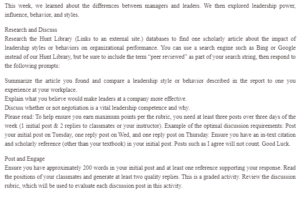Leadership in an Organization
Leadership is an essential element of any organization. A good leader should positively influence employees to work towards a specific goal. Lack of good leadership is likely to result in deficient performance. As a result, the credibility of an organization’s services or products is reduced significantly. According to the article’s findings, a good leadership style, such as the democratic style, can influence workers to perform exceptionally (Aibieyi, 2014). However, leaders need to acquire leadership skills, which increases the leaders’ effectiveness in an organization. The proposed leadership skills include technical, conceptual, human, and proportional skills. Subsequently, negotiation is an essential leadership skill and can be categorized under the human skills that a leader should have. It enables brainstorming and decision-making with other staff members, leading to adopting the most appropriate choice (Shvindina, 2017).
Furthermore, the article discusses diverse types of leadership styles. The participative styles are highly recommended because they involve employees in decision-making. The democratic leadership style, compared to the authoritative style, inspires more trust and confidence between employees and management (Aibieyi, 2014). In a practical setting, the classic technique involves top-down decision-making, leaving employees little to no involvement. Employees only follow instructions that are made by the top management. On the other hand, the democratic leadership style is characterized by the participation of employees in the decision-making processes (Shelton & Yates, 2012). This aspect makes a significant difference in organizations that use the two styles.
References
Aibieyi, S. (2014). Approaches, Skills, And Styles Of Leadership in Organisations. Review of Public Administration and Management, 3(5), 53-59.
Shelton, P., & Yates, L. (2012). Nice Guys (and Gals) Finish First: Ethical Leadership and Organizational Trust, Satisfaction, and Effectiveness. Digital Commons, 3-19.
Shvindina, H. (2017). Leadership as a driver for organizational change. Business Ethics and Leadership, 1(1), 74-82. https://doi.org/10.21272/bel.2017.1-09
ORDER A PLAGIARISM-FREE PAPER HERE
We’ll write everything from scratch
Question
This week, we learned about the differences between managers and leaders. We then explored leadership power, influence, behavior, and styles.

Leadership in an Organization
Research and Discuss
Research the Hunt Library (Links to an external site.) databases to find one scholarly article about the impact of leadership styles or behaviors on organizational performance. You can use a search engine such as Bing or Google instead of our Hunt Library, but be sure to include the term “peer reviewed” as part of your search string, then respond to the following prompts:
Summarize the article you found and compare a leadership style or behavior described in the report to one you experience at your workplace.
Explain what you believe would make leaders at a company more effective.
Discuss whether or not negotiation is a vital leadership competence and why.
Please read: To help ensure you earn maximum points per the rubric, you need at least three posts over three days of the week (1 initial post & 2 replies to classmates or your instructor). Example of the optimal discussion requirements: Post your initial post on Tuesday, one reply post on Wed, and one reply post on Thursday. Ensure you have an in-text citation and scholarly reference (other than your textbook) in your initial post. Posts such as I agree will not count. Good Luck.
Post and Engage
Ensure you have approximately 200 words in your initial post and at least one reference supporting your response. Read the positions of your classmates and generate at least two quality replies. This is a graded activity. Review the discussion rubric, which will be used to evaluate each discussion post in this activity.


